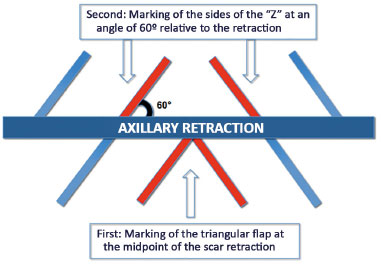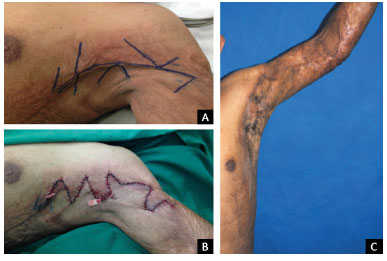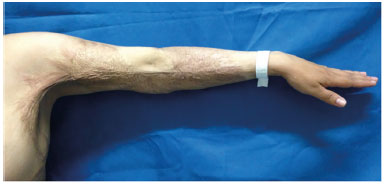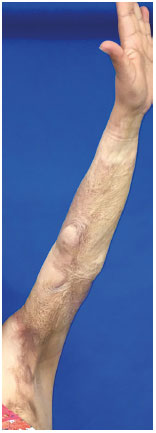

Original Article - Year 2017 - Volume 32 -
Z-plasty in axillary retraction: techniques and strategies to facilitate learning by medical residents
Zetaplastia na retração axilar: técnica e tática para facilitar o aprendizado dos residentes
ABSTRACT
INTRODUCTION: Herein, we present two cases of post-burn retraction of the axillary region, which were subsequently surgically corrected using multiple Z-plasties. We present a marking strategy to facilitate the learning of this procedure by plastic surgery residents.
METHODS: Two patients with axillary and upper limb retractions due to burns with hot liquids were surgically treated using multiple Z-plasties. The strategy proposed in this study recommends the marking of the triangular flap located at the midpoint of the axillary retraction, which then advances and crosses the axis of the scar. Then, subsequent flaps are made at an angle of 60º to each other. We believe that this systematization of marking facilitates the planning and learning of Z-plasty.
RESULTS: The study patients achieved an adequate range of motion and functional recovery of the affected limb postoperatively. We observed no cases of necrosis of the flap ends, which should be carefully worked and slightly rounded. The execution of the procedure was simple using the suggested marking strategy.
CONCLUSION: The presented marking strategy was reproducible and easy to learn. Multiple Z-plasties were effective in restoring the range of motion of the areas affected by burns that were treated using this method.
Keywords: Burns; Scar; Surgical flaps; Teaching; Axilla.
RESUMO
INTRODUÇÃO: São apresentados dois casos de retração em região axilar após queimadura em que a correção cirúrgica foi realizada empregando-se zetaplastias múltiplas. Apresentamos uma tática de marcação que visa facilitar o aprendizado desse procedimento pelos residentes de Cirurgia Plástica.
MÉTODOS: Dois pacientes com retrações axilares e de membros superiores após queimadura com líquido aquecido foram submetidos à correção cirúrgica empregando-se a zetaplastia múltipla. A tática de planejamento proposta nesse estudo preconiza primeiro a marcação do retalho triangular localizado no ponto médio da retração axilar, o qual irá avançar e cruzar o eixo da cicatriz, e a partir daí o desenho dos retalhos subsequentes com ângulo de 60º entre si. Acreditamos que essa sistematização da marcação facilita o planejamento e aprendizado da plástica em Z.
RESULTADOS: Os pacientes apresentaram adequadas amplitude de movimento e recuperação funcional do membro acometido no pós-operatório. Não houve necrose das extremidades dos retalhos, que preconizamos serem cuidadosamente trabalhadas e um pouco arredondadas; e a execução do procedimento foi simples devido à tática de marcação que aplicamos.
CONCLUSÃO: A tática de marcação que apresentamos é reprodutível e de fácil aprendizado. A zetaplastia múltipla foi eficaz em restabelecer a amplitude de movimento das áreas com sequela de queimadura tratadas com esse método.
Palavras-chave: Queimaduras; Cicatriz; Retalhos cirúrgicos; Ensino; Axila.
The increased survival of patients who suffer burns in the past three decades is the result of advances in the systematization of acute care procedures. In the past, the survival rate of patients with burns covering 30% to 40% of the body surface was 50%. Presently, 50% of patients with severe burns covering 70% of their body surface can survive when treated in urban centers1.
Increased survival results in a larger number of patients with burn sequelae, particularly scar contractures in the armpits and elbows2. In the literature, the incidence of axillary contracture after burns ranges between 17% and 38%3,4, and this complication results in significant morbidity and functional limitations.
The early introduction of methods for the repair of burn sequelae is essential for the restoration of body shape and function as well as the return of the patient's social life. Whenever possible, axillary grafts should be avoided because they require longer immobilization in the postoperative period. Moreover, the risk of recurrence of the deformity increases because of secondary contraction of the graft.
Axillary retractions should preferably be treated with local or neighboring flaps, including the fasciocutaneous flap of the inner face of the arm, V-Y advancement flaps, or Z-plasties. Z-plasty has been used for many years and is an essential tool in reparative plastic surgery after burns because of its consistent results, ease of learning, and low donor site morbidity5.
OBJECTIVE
The objective of this work was to report a marking strategy that facilitates the planning, execution, and learning of multiple Z-plasties, thereby highlighting the favorable outcomes obtained with the systematization of preoperative marking. We present two cases of patients with alcohol burns with axillary cicatricial retractions and functional limitations, which were subsequently corrected with multiple Z-plasties that were planned according to the proposed marking strategy.
METHODS
Plans for multiple Z-plasties are highlighted in two cases of patients who developed alcohol burns in the left upper limb and who experienced retractions and functional limitations in the axilla and antecubital fossa. Both patients underwent surgical treatment at the Sector of Burn Sequelae of the Plastic Surgery Department of the Federal University of São Paulo (Universidade Federal de São Paulo - UNIFESP), São Paulo, Brazil, by the same surgeon. This study complied with the principles of the Helsinki declaration.
We used the technique of multiple Z-plasties to correct axillary retractions. The retraction in the left antecubital fossa was resolved by double Z-plasty in one patient and excision and partial skin graft in the other patient. The range of motion of the left upper limb was evaluated in these patients before and after surgery.
The following strategy was used to facilitate the understanding and planning of transposition flaps in Z-plasties. We first marked the flap that crosses the axis of the scar retraction and that is located at the midpoint of the retraction. From this marking, we planned the other sides of the "Z" at an angle of 60º relative to this triangular flap.
The number of Z-plasties required depends on the size of the retraction and the range of motion to be achieved. These flaps are made by marking the first flap at the midpoint of the retraction, thereby facilitating the marking of the other branches of the Z-plasty (Figure 1).

Figure 1. Strategy for the marking of multiple Z-plasties. We initially mark the flap that crosses the axis of the scar retraction and that is located at the midpoint of the retraction. From this marking, we plan the other sides of the Z-plasty.
RESULTS
Case 1: A 30-year-old male patient, previously healthy, was a victim of alcohol burn 15 years before admission to the Plastic Surgery Department of UNIFESP. The initial treatment provided in another service was conservative and included serial debridement. Upon admission to the Clinic of Burn Sequalae of São Paulo Hospital, the patient presented with skin changes that were typical of second-intention healing in the left arm and scar retraction in the axilla and antecubital fossa with impairment of left arm abduction and left forearm extension (Figure 2).

Figure 2. Clinical case 1. A male patient with scar retraction in the left axilla and anterior aspect of the left upper limb with a significant limitation of abduction and extension of the affected limb.
After clinical assessment, our medical team recommended multiple Z-plasties in the axillary scar that was associated with excision and split-thickness skin graft in the left antecubital fossa. The donor site of the graft was the left thigh. The occlusive dressing was performed using rayon, gauze, and bandage, and the left upper limb was immobilized with a plaster cast until the fifth day after surgery. The evolution of the case was satisfactory, with the release of scars and a restoration of the range of motion of the upper limb during the postoperative period (Figure 3).

Figure 3. Before and after surgery. A: Marking before surgery; B: Immediately after surgery; C: One year after surgery. The release of the scars and a restoration of the range of motion are observed.
Case 2: A 32-year-old female patient was a victim of alcohol burn in the left upper limb 7 years before admission. The patient was treated at another hospital with serial debridement and grafting, but developed cicatricial retractions in the axilla and anterior face of the left upper limb and impairment of limb function (Figure 4).

Figure 4. Clinical case 2. The patient was asked to abduct the left arm. We observed a limitation in the movement of the limb.
The patient underwent multiple Z-plasties in the axilla and left antecubital fossa. The postoperative course was satisfactory, thereby allowing for proper movement of the axilla and antecubital fossa of the left upper limb (Figure 5).

Figure 5. Clinical case 2. The patient showed a good functional recovery and full extension of the upper limb one year after surgery.
DISCUSSION
Scar contractures after burns represent the complication that most often requires restorative surgical intervention6. These contractures largely affect the joints and cause a limitation in the range of motion and flexion deformity.
Several methods are available for the correction of scar retractions in the axilla. However, Z-plasty is notable for its simplicity and effectiveness. Z-plasty consists of the transposition of two or more triangular flaps to modify the axis of the final scar. Z-plasty flaps often have a 60º angle to one another, thereby resulting in an elongation of the scar by 75%.
These flaps may be elevated safely in the healing skin, which allows them to be relatively thick (i.e., with underlying fatty tissue), while also maintaining round, rather than acute, flap tips. Furthermore, it allows for flap suturing without tension.
The strategy proposed in this study involves first marking the triangular flap located at the midpoint of the axillary retraction, which advances and crosses the scar axis. Then, the subsequent flaps are marked at an angle of 60º to one another. We believe that this systematization of marking facilitates the planning and learning of Z-plasty. Multiple smaller Z-plasties are preferable to a single larger Z-plasty because the former promotes a better breakdown of skin tension lines and a greater elongation of the scar7.
In the reported cases, we elected to perform multiple Z-plasties in the axillary region. The increase in the range of motion in the affected upper limb resulted in a functional improvement in and quality of life of patients. These results support previous reports regarding the effectiveness of Z-plasties for the repair of retractions after burns.
Multiple Z-plasties in the axillary region allow for the resolution of scar retractions after burns in a simple and effective manner, which includes low donor site morbidity. Furthermore, the systematization of preoperative marking, as demonstrated in this study, facilitates the learning and implementation of Z-plasty.
COLLABORATIONS
MARM Analysis and/or interpretation of data; conception and design of the study; writing the manuscript or critical review of its contents.
RRR Conception and design of the study; Writing the manuscript or critical review of its contents.
LMF Final approval of the manuscript.
REFERENCES
1. Gibran NS, Heimbach DM. Current status of burn wound pathophysiology. Clin Plast Surg. 2000;27(1):11-22.
2. Schneider JC, Holavanahalli R, Helm P, Goldstein R, Kowalske K. Contractures in burn injury: defining the problem. J Burn Care Res. 2006;27(4):508-14. PMID: 16819356 DOI: http://dx.doi.org/10.1097/01.BCR.0000225994.75744.9D
3. Ramos RR, Okamoto RH. Sequelas de queimaduras. In: Ferreira LM. Guia de Cirurgia Plástica. 1a ed. Barueri: Manole; 2007.
4. Richard R, Miller S, Staley M, Johnson RM. Multimodal versus progressive treatment techniques to correct burn scar contractures. J Burn Care Rehabil. 2000;21(6):506-12. DOI: http://dx.doi.org/10.1097/00004630-200021060-00006
5. Oliveira CL, Arruda AM, Reis Filho GC, Santos L, Anbar RA. Tratamento cirúrgico de retrações axilares e mentotorácica com zetaplastia. Rev Bras Cir Plást. 2010;25(1):213-6.
6. Nişanci M, Er E, Işik S, Sengezer M. Treatment modalities for post-burn axillary contractures and the versatility of the scapular flap. Burns. 2002;28(2):177-80. PMID: 11900943 DOI: http://dx.doi.org/10.1016/S0305-4179(01)00090-0
7. Cartotto R, Cicuto BJ, Kiwanuka HN, Bueno EM, Pomahac B. Common postburn deformities and their management. Surg Clin North Am. 2014;94(4):817-37. PMID: 25085090 DOI: http://dx.doi.org/10.1016/j.suc.2014.05.006
Universidade Federal de São Paulo, São Paulo, SP, Brazil
Institution: Universidade Federal de São Paulo, São Paulo, SP, Brazil.
Corresponding author:
Mariana Alcantara Rodrigues de Moraes
Rua Botucatu, 740, 2º andar
São Paulo, SP, Brazil Zip Code 04023-062
E-mail: mari74.alcantara@gmail.com
Article received: September 21, 2016.
Article accepted: February 21, 2017.
Conflicts of interest: none.


 Read in Portuguese
Read in Portuguese
 Read in English
Read in English
 PDF PT
PDF PT
 Print
Print
 Send this article by email
Send this article by email
 How to Cite
How to Cite
 Mendeley
Mendeley
 Pocket
Pocket
 Twitter
Twitter